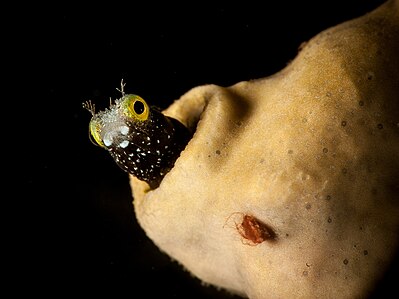Talk:Acanthemblemaria spinosa
| This article is rated Start-class on Wikipedia's content assessment scale. It is of interest to the following WikiProjects: | ||||||||||||||||||||||||||||
| ||||||||||||||||||||||||||||
Featured picture scheduled for POTD
[edit]Hello! This is to let editors know that File:2017, cuba,_jardines_aggressor,_playa_bonita,_spineyhead_blennie_(23700572188).jpg, a featured picture used in this article, has been selected as the English Wikipedia's picture of the day (POTD) for September 10, 2023. A preview of the POTD is displayed below and can be edited at Template:POTD/2023-09-10. For the greater benefit of readers, any potential improvements or maintenance that could benefit the quality of this article should be done before its scheduled appearance on the Main Page. If you have any concerns, please place a message at Wikipedia talk:Picture of the day. Thank you! — Amakuru (talk) 18:37, 4 September 2023 (UTC)

|
The spinyhead blenny (Acanthemblemaria spinosa) is a species of blenny native to the tropical western Atlantic Ocean and Caribbean Sea, with a range extending from the Antilles, the Bahamas, and Florida to Curaçao. It typically inhabits small, rocky reefs surrounded by sand, and is known as a tube blenny from its habit of occupying a hole in a coral or an empty worm tube from which it pokes out its head. The fish has a mottled black, white and red coloration over the entire body, which is rather elongated. As with most blennies, its head has small, hair-like appendages over the eyes, which are large and red. The dorsal fin has 20 to 22 spines and 13 to 16 soft rays. The anal fin has two spines and 21 to 25 soft rays. It grows to a total length of 2.8 cm (1.1 in). Photograph credit: q phia
Recently featured:
|


